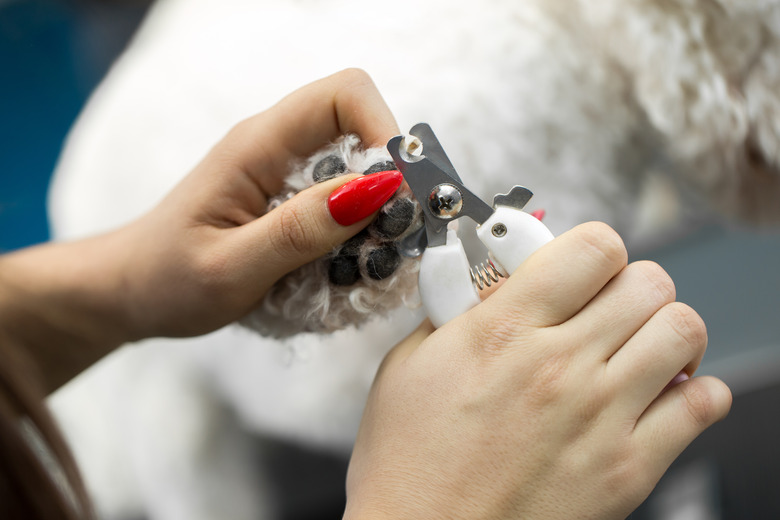What Are The Dangers Of Long Nails In Dogs?
That click-clack sound you hear on your wood floor or bathroom tile means your dog is approaching, but if you can tell your pup is on the way just by listening to his feet, it could mean his dog nails are too long, which is a problem. You might think nails aren't a big deal and instead focus on your pet's nutrition and exercise, but grooming this body part can keep your pet's feet feeling good and can also contribute to his overall good health.
Why overly long nails hurt dogs
Why overly long nails hurt dogs
A canine's nails are useful devices for digging in the dirt, scratching itchy ears, holding a squeaky toy, or even for defending herself when faced with a predator. And yet, domesticated dogs aren't really fighting for their lives every day or hunting and gathering their own food, which means your pet's nails aren't naturally trimmed by the ground or in combat. So, the job falls to owners, because if your dog's nails become too long, problems can set in.
The health issues related to dog nails that are too long include injured tendons and too much pressure on your pup's feet when nails push into the nail bed. Sore feet can swell, which can lead to a case of arthritis and an unsteady gait that can create hip trouble. When dog nails are too long, it prevents the paw pads from reaching the ground, causing your canine to slip, trip, or fall down. The worst discomfort comes from nails that grow inward and end up poking into the paw pad, which hurts all the time but is especially bad when walking.
Try a dog nail grinder
Try a dog nail grinder
Do you want to keep some supplies at home so you can take care of your dog's nails? A dog nail grinder is recommended by vets and pro groomers. This device gently works to sand down the nail and helps to prevent cutting too closely and injuring your pet. This grinder, which is also called a Dremel tool for trimming dog nails, is also rather easy for beginners to use at home. Other options include dog nail scissors or clippers.
How often are nails trimmed?
How often are nails trimmed?
The frequency of nail trimming at your house depends on the breed type and the amount of activity in which your dog engages. A very active dog who digs in the yard all day or an urban pup whose nails sweep along concrete sidewalks may need less trimming than an older, more sedentary pup. A good rule of thumb is to strive to trim your dog's nails once a month, though the front and back nails grow and wear down at different rates, so you may not trim all the nails every time.
The dew claw, however, which is also called the thumb claw, is a funny one that doesn't reach the ground in lots of breeds, so check this one each time to see whether it's growing too long. Another way to determine whether it's time to trim your dog's nails is to crouch down on the floor and see whether they touch the ground when he walks. Loud clicking on the floor is another easy indicator you'll notice too.
Tips for dog nail trimming
Tips for dog nail trimming
Are you ready to try your hand at trimming your dog's nails? Whether you use a dog nail grinder, a Dremel tool for trimming dog nails, or something else, some tips can help:
- Grab a pal. Does your dog squirm when you groom her? Enlist a friend to hold your dog.
- Offer treats. Tasty bits can work as a distraction during this process.
- Locate the quick. Before cutting, you want to find the quick inside each nail, which is pink tissue that contains a blood vessel and is visible in light-colored nails. In darker nails, you'll have to cut in tiny increments to avoid the quick. Your goal is to trim up to the quick but not the actual tissue lest you cause your dog to yelp and bleed. (Don't worry; it happens.)
- Trim tiny bits. At a 45-degree angle, use clippers or dog nail scissors to cut below the quick just a millimeter or two at a time. Continue until the nail starts to curve or you're very close to the quick.
- Staunch the flow. You'll no doubt nick the quick at some point, so keep some corn starch on hand. This powdery ingredient can stop the bleeding and seal the cut.
- Try sanding. With the two grinding tools, hold the devices at the same angle as you work on the nails.
- Work up to a full set. Trimming just one or two nails at a time is fine, as this slower pace may get your dog used to the feeling of the clippers or sander.
- Book a groomer. Are you having a tough time? It's fine to head to a professional groomer or even your vet's office for your dog's nail clipping needs.
